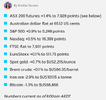bigdog
Retired many years ago
- Joined
- 19 July 2006
- Posts
- 8,242
- Reactions
- 5,700
Stock market today: Asian shares are mixed after Bank of Japan ups key rate for 1st time in 17 years
Shares are mixed in Asia after the Bank of Japan hiked its benchmark interest rate for the first time in 17 years, ending a longstanding negative rate policy.
Wall Street rises ahead of a big week for central banks
By STAN CHOENEW YORK (AP) — U.S. stocks rose Monday ahead of a busy week for central banks around the world that could dictate where interest rates go.
The S&P 500 added 32.33 points, or 0.6%, to 5,149.42, coming off its first back-to-back weekly losses since October. At one point during the day, it was on track to surpass its all-time closing high set last week.
The Dow Jones Industrial Average rose 75.66, or 0.2%, to 38,790.43, and the Nasdaq composite gained 130.27, or 0.8%, to 16,103.45.
The highlight for Wall Street this week will likely be the Federal Reserve’s meeting on interest rates, which ends on Wednesday. The widespread expectation is for the central bank to hold its main interest rate steady at its highest level since 2001.
But Fed officials will also give updated forecasts for where they see interest rates heading this year and in the long run. They earlier had penciled in three cuts to rates this year, which would relieve pressure on the economy and financial system.
Recent reports on inflation have consistently been coming in worse than expected, though. That could force the Fed to trim how many rate cuts it foresees delivering this year.
Such a move would be a sore disappointment for Wall Street, where stock prices have already run up partly on expectations for lower rates. Treasury yields in the bond market have also eased since last autumn on such expectations, though they’ve pared those losses on worries about stubbornly high inflation.
It’s possible that the Fed could keep its main interest rate near its current level throughout this year, according to Joe Davis, Vanguard’s chief global economist. The investment giant recently raised its baseline outlook for the U.S. economy to see no recession in 2024, but it also raised its forecast slightly for underlying inflation trends.
Across the Pacific, the Bank of Japan will announce its latest decision on interest rates on Tuesday. It’s been keeping rates below zero in hopes of goosing the economy and inflation. Speculation is rising that wages for Japanese workers are rising enough for the Bank of Japan to finally move rates higher.
Across the Atlantic, the Bank of England will announce its latest decision on interest rates later in the week.
On Wall Street, Nvidia rose 0.7% after paring an earlier, bigger gain as it kicked off its annual conference for developers.
A frenzy around artificial-intelligence technology on Wall Street has sent the stocks of Nvidia and other players zooming so high that critics call it a bubble. Nvidia has grown into the U.S. stock market’s third-largest stock.
Other Big Tech stocks also pushed the S&P 500 upward to snap a three-day losing streak, its longest in more than two months. Alphabet rallied 4.6%, and Tesla jumped 6.3% to trim its loss for the year so far.
On the losing end of Wall Street was Hertz Global Holdings, which skidded 6.2% to bring its loss for the year so far to 31.6%. Its chair and CEO, Stephen Scherr, will resign at the end of March. The company named Wayne “Gil” West as its CEO. He’s a former executive at Cruise, the self-driving car company, and at Delta Air Lines.
Trading was mixed on Wall Street, and the smaller stocks in the Russell 2000 index slipped 0.7%.
Boeing sank another 1.5% to bring its loss for the year to 31%. It’s been struggling with concerns about its manufacturing quality, and its latest negative headline came on Friday. Workers found a panel missing on an older Boeing 737-800 after it arrived at its destination in southern Oregon from San Francisco.
In the bond market, the yield on the 10-year Treasury rose to 4.33% from 4.31% late Friday.
In stock markets abroad, Japan’s Nikkei 225 jumped 2.7%. Shares of both Nissan Motor and Honda Motor Co.’s shares climbed after the two automakers agreed on a partnership in electric vehicles.
Outside of a 1% jump for stocks in Shanghai, moves were much more modest elsewhere across Asia and Europe.
ASX 200 expected to edge higher
The Australian share market is expected to edge higher on Tuesday following a positive start to the week on Wall Street.According to the latest SPI futures, the ASX 200 is poised to open the day 3 points higher.
U.S. stocks rose Monday ahead of a busy week for central banks around the world that could dictate where interest rates go.
The S&P 500 added 32.33 points, or 0.6%, to 5,149.42, coming off its first back-to-back weekly losses since October. At one point during the day, it was on track to surpass its all-time closing high set last week.
The Dow Jones Industrial Average rose 75.66, or 0.2%, to 38,790.43, and the Nasdaq composite gained 130.27, or 0.8%, to 16,103.45.
The highlight for Wall Street this week will likely be the Federal Reserve’s meeting on interest rates, which ends on Wednesday. The widespread expectation is for the central bank to hold its main interest rate steady at its highest level since 2001.

